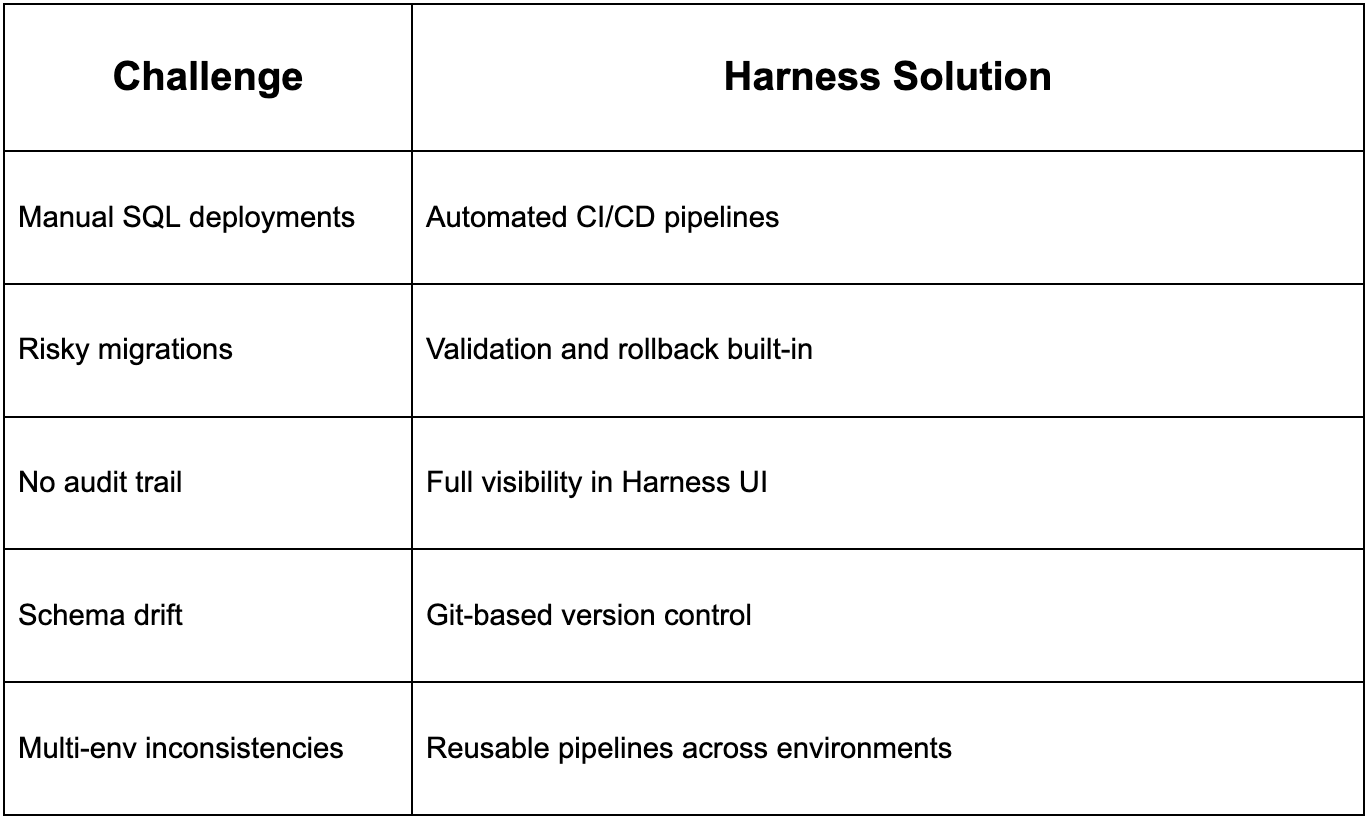
Harness Database DevOps now supports CockroachDB, bringing CI/CD automation to distributed SQL databases. Teams can manage schema changes through Git-driven workflows for consistency, traceability, and rollback safety. This integration simplifies multi-environment deployments, reduces human error, and accelerates database delivery.
CockroachDB is known for its distributed SQL power and fault tolerance. It can scale horizontally and handles multi-region workloads very well while keeping applications online even when nodes fail. But while CockroachDB simplifies scaling, managing schema changes across multiple environments can still be a pain. Developers often face issues like schema drift, inconsistent rollouts, or manual SQL execution during releases.
This is where Harness Database DevOps changes the game. It brings CI/CD discipline to database management. Now that Harness supports CockroachDB, you can automate database updates with the same precision and visibility you expect from application deployments.
A Git-Driven Approach to Schema Management
Traditional database updates rely on manual scripts and DBA interventions. Harness replaces that with a Git-driven workflow:
- Developers define schema changes in a changelog format.
- The changelog is stored in Git for review and version control.
- Harness pipelines automatically apply those changes to CockroachDB.
This ensures:
- Every schema update is auditable.
- Rollbacks are consistent.
- Teams can collaborate safely through pull requests.
Think of it as DevOps for your database, reliable, traceable, and continuous.
How Harness Integrates with CockroachDB
Harness uses JDBC connectors (PostgreSQL compatible) to communicate with CockroachDB.
During a pipeline run, Harness leverages Liquibase to interpret the changelog and execute migrations on your cluster.
Here’s the big picture:
- The developer makes changes to schema and commits that changelog to Git.
- Harness pipeline detects the commit and runs automatically.
- Database DevOps executes the schema changes via the CockroachDB connector.
- Logs, version history, and results are shown in the Harness UI.
This integration transforms CockroachDB schema updates from a manual task into a controlled CI/CD process.
How to Setup the CockroachDB in Harness Database DevOps
Let’s look at the setup at a high level :
- Prepare: Have a running CockroachDB cluster (port 26257), a Harness account with Database DevOps, a Delegate in Kubernetes, and a Git repo for changelogs.
- Author: Define schema updates as Liquibase changelogs (YAML recommended) and commit to Git.
- Connect: Create a JDBC connector in Harness (Postgres driver, TLS recommended).
- Automate: Build a pipeline with an Apply Database Schema step that references your changelog and connector.
- Execute & Observe: Trigger the pipeline, validate Liquibase logs, and review applied changeSets in Harness.
Why This Integration Matters ?

CockroachDB’s distributed design fits perfectly with Harness’s declarative, version-controlled workflows, helping teams ship database changes faster and safer.
Real-World Impact
Consider a SaaS company operating CockroachDB clusters across multiple regions to serve a global user base. Each week, developers push schema changes — adding new tables, refining indexes, or evolving data models to support new features.
Previously, every change required manual intervention. DBAs ran SQL scripts by hand, coordinated release windows across time zones, and updated migration logs in spreadsheets. This process was not only time-consuming but also prone to drift and human error. After adopting Harness Database DevOps, that manual process becomes a seamless, automated pipeline::
- Developers submit changelogs in Git.
- Harness pipelines automatically validate and deploy schema changes.
- Audit logs track every change for compliance.
The team moves faster, reduces human error, and gains complete traceability.
Conclusion
With every schema change tracked, validated, and version-controlled, teams can ship updates faster while maintaining compliance and operational safety. Rollbacks, audit trails, and environment consistency become part of the process and not just an afterthoughts.
This integration empowers both developers and DBAs to collaborate seamlessly through a single pipeline that brings transparency, repeatability, and confidence to database operations. Whether you’re running CockroachDB across multiple regions or scaling up new environments, Harness ensures your database evolves at the same pace as your application. If you’re looking to modernize your database delivery pipeline, start with the Harness Database DevOps documentation and try integrating CockroachDB today.
Frequently Asked Question (FAQ)
1. Does Harness support all Liquibase operations with CockroachDB?
Yes. Harness uses Liquibase under the hood, so most standard operations — like createTable, addColumn, createIndex, and alterTable — work seamlessly with CockroachDB. A few engine-specific operations may differ due to CockroachDB’s SQL dialect, but Liquibase provides compatible fallbacks.
2. Can I roll back a failed migration automatically?
Absolutely. Harness tracks every executed changeSet and supports Liquibase rollback commands. You can trigger rollbacks manually or define rollback scripts in your changelog. This ensures that failed schema updates don’t impact production stability.
3. What happens if two developers commit conflicting schema changes?
Harness detects version conflicts based on Liquibase changeSet IDs and Git history. If two changelogs modify the same table differently, the pipeline flags it before applying. You can resolve the conflict in Git, re-commit, and re-run the pipeline safely.
4. How does Harness ensure migration performance in CockroachDB?
Harness pipelines use containerized execution to isolate database operations. Since CockroachDB distributes workloads, most migrations scale horizontally. You can also configure throttling, pre-deployment validations, or dry runs to measure performance impact before actual execution.
5. Is my database connection secure when using Harness?
Yes. Harness encrypts all secrets (JDBC credentials, certificates, and keys) using its Secret Manager. TLS is strongly recommended for CockroachDB, and Harness supports SSL verification flags like sslmode=verify-full. Credentials are never exposed in pipeline logs.

